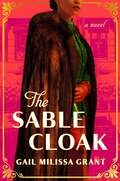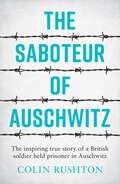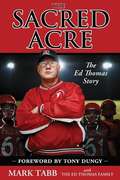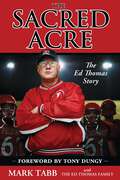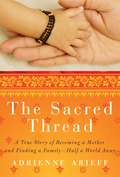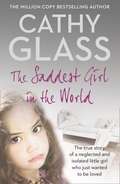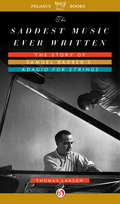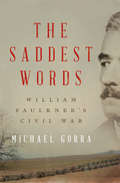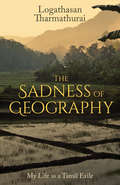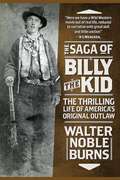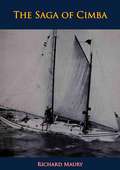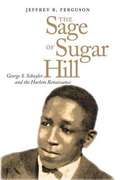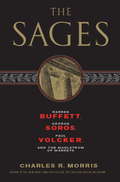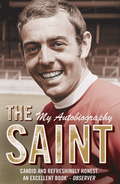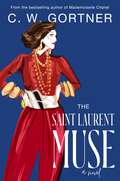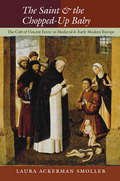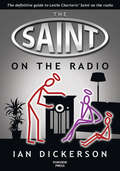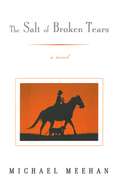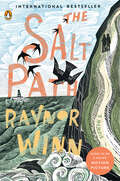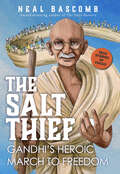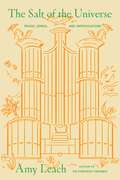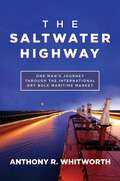- Table View
- List View
The Sable Cloak
by Gail Milissa GrantIn this atmospheric novel set in the Jim Crow South, a powerful Black family fights to protect their empire—for readers of Tayari Jones. Jordan Sable, a prosperous undertaker turned political boss, has controlled the Black vote in St. Louis for decades. Sara, his equally formidable wife, runs the renowned funeral establishment that put the Sable name on the map. Together they have pushed through obstacles in order to create a legacy for their children. When tragedy bursts their carefully constructed empire of dignity and safety, the family rallies around an unconventional solution. But at what cost? Set in the Midwest in the 1940s, The Sable Cloak is a rarely seen portrait of an upper middle class, African American family in the pre-Civil Rights era. This deeply personal novel inspired by the author's own family history delves into legacy and the stories we tell ourselves, and celebrates a largely self-sustaining, culturally rich Missouri community that most Americans may not be aware of.
The Saboteur of Auschwitz: The Inspiring True Story of a British Soldier Held Prisoner in Auschwitz
by Colin RushtonFor fans of The Tattooist of Auschwitz, The Librarian of Auschwitz and The Choice, this is the incredible true story of a British soldier POW.In 1942, young British soldier Arthur Dodd was taken prisoner by the German Army and transported to Oswiecim in Polish Upper Silesia. The Germans gave it another name, now synonymous with mankind’s darkest hours. They called it Auschwitz.Forced to do hard labour, starved and savagely beaten, Arthur thought his life would end in Auschwitz. Determined to go down fighting, he sabotaged Nazi industrial work, risked his life to alleviate the suffering of the Jewish prisoners and aided a partisan group planning a mass break-out.This shocking true story sheds new light on the operations at the camp, exposes a hierarchy of prisoner treatment by the SS and presents the largely unknown story of the military POWs held there.
The Sacred Acre: The Ed Thomas Story
by Mark TabbOn a Sunday in May 2008, an F-5 tornado struck the town of Parkersburg, Iowa, killing eight people and destroying 250 homes and businesses within 34 seconds. The next day, Parkersburg's beloved football coach, Ed Thomas, made a stunning prediction: 'God willing, we will play our first home game here on this field this season. ' One hundred days later, the home team scored a victory on the field they dubbed 'The Sacred Acre,' serving as a galvanizing point for the town to band together and rebuild. But just as Parkersburg was recovering, another devastating tragedy struck. While working with a group of football and volleyball players early one morning, one of Ed's former students walked in and gunned him down point blank. Ed Thomas was 58. The murder of this hometown hero spread across national news headlines. Ed's community and family reeled from shock. Yet the story doesn't end here. What happened next proves that even a double tragedy is no match for faith, love . . . and the power of forgiveness.
The Sacred Acre: The Ed Thomas Story
by Mark TabbOn a Sunday in May 2008, an F-5 tornado struck the town of Parkersburg, Iowa, killing eight people and destroying 250 homes and businesses within 34 seconds. The next day, Parkersburg’s beloved football coach, Ed Thomas, made a stunning prediction: “God willing, we will play our first home game here on this field this season.” One hundred days later, the home team scored a victory on the field they dubbed “The Sacred Acre,” serving as a galvanizing point for the town to band together and rebuild. But just as Parkersburg was recovering, another devastating tragedy struck. While working with a group of football and volleyball players early one morning, one of Ed’s former students walked in and gunned him down point blank. Ed Thomas was 58. The murder of this hometown hero spread across national news headlines. Ed’s community and family reeled from shock. Yet the story doesn’t end here. What happened next proves that even a double tragedy is no match for faith, love … and the power of forgiveness.
The Sacred Thread: A True Story of Becoming a Mother and Finding a Family--Half a World Away
by Adrienne ArieffA touching and surprising memoir about one woman's journey to motherhood and family that illustrates the power of love and triumph of the human spirit.After three heartbreaking losses, Adrienne Arieff thought her dreams of becoming a mother might never come true. She and her husband soon discovered, however, that parenthood was still possible, but it would require a gift from a perfect stranger, faith and determination. Half a world away, in a small village in India, Vaina was happily married with three small children, but with little means to support her family or to build a better life. So Adrienne traveled to Anand, in a remote rural pocket of India near the Pakistani border, where the Akansksha clinic is located, to meet with Dr. Nayna Patel, an expert in surrogacy. There, Adrienne met Vaina, who courageously agreed to be a surrogate and carry Adrienne's child, an act which would, in turn, help Vaina to provide for her own children. After a course of IVF in India, Adrienne's role was just beginning in a process that as yet has no firm set of social mores. Unlike many genetic moms who return to their homes and wait for their baby to be born, Adrienne couldn't bear to have this pregnancy progress without her. She wanted to feel a connection both to her growing child and to Vaina, the woman who was offering this remarkable gift. So Adrienne decided to go back to Anand, to be Vaina's partner for the last months of her pregnancy. This choice brought its own heartaches and revelations, chief among them, how do you develop a relationship when you don't share a language or culture? But somehow these two mothers, united by a shared goal, found that within weeks, they could say anything and everything with just one look, one squeeze of the hand, one smile. Poignant, eye-opening, and bittersweet, The Sacred Thread is a memoir of the astonishing journey these two young women took to create a family through international surrogacy. It is the very personal story of embarking upon this process, and shedding light on a growing medical trend that is often shrouded in misconception and prejudice. But, more importantly, The Sacred Thread is a tale of immersing oneself in a foreign culture and foreign land; becoming part of a group of expectant mothers, bonded by their hope for children, and following them on the euphoric highs and crushing lows of their journey; and the development of a deep bond between women who have absolutely nothing in common, except for a shared love of family and children.From the Hardcover edition.
The Saddest Girl in the World
by Cathy GlassThe bestselling author of Damaged tells the true story of Donna, who came into foster care aged ten, having been abused, victimised and rejected by her family. Donna had been in foster care with her two young brothers for three weeks when she is abruptly moved to Cathy's. When Donna arrives she is silent, withdrawn and walks with her shoulders hunched forward and her head down. Donna is clearly a very haunted child and refuses to interact with Cathy's children Adrian and Paula. After patience and encouragement from Cathy, Donna slowly starts to talk and tells Cathy that she blames herself for her and her brothers being placed in care. The social services were aware that Donna and her brothers had been neglected by their alcoholic mother, but no one realised the extent of the abuse they were forced to suffer. The truth of the physical torment she was put through slowly emerges, and as Donna grows to trust Cathy she tells her how her mother used to make her wash herself with wire wool so that she could get rid of her skin colour as her mother was so ashamed that Donna was mixed race. The psychological wounds caused by the bullying she received also start to resurface when Donna starts reenacting the ways she was treated at home by hitting and bullying Paula, so much so that Cathy can't let Donna out of her sight. As the pressure begins to mount on Cathy to help this child, things start to get worse and Donna begins behaving in erratic ways, trashing her bedroom and being regularly abusive towards Cathy's children. Cathy begins to wonder if she can find a way to help this child or if Donna's scars run too deep.
The Saddest Music Ever Written
by Thomas LarsonAn exploration of the cultural impact of Samuel Barber's Adagio for Strings, the Pietá of music, and its enigmatic composer In the first book ever to explore Samuel Barber's Adagio for Strings,music and literary critic Thomas Larson tells the story of the prodigal composer, his seminal masterpiece and its fascinating history as America's secular hymn for grieving our dead. The Adagio's sonorous intensity also speaks of the turbulent inner life of its composer, a melancholic who, in later years, descended into alcoholism and severe depression. Part biography, part cultural history, part memoir, The Saddest Music Ever Written captures the deep emotion Barber's great elegy has stirred throughout the world during its seventy-five-year history, becoming an icon of our national soul.
The Saddest Words: William Faulkner's Civil War
by Michael GorraHow do we read William Faulkner in the twenty-first century? asks Michael Gorra, in this reconsideration of Faulkner's life and legacy. William Faulkner, one of America’s most iconic writers, is an author who defies easy interpretation. Born in 1897 in Mississippi, Faulkner wrote such classic novels as Absolom, Absolom! and The Sound and The Fury, creating in Yoknapatawpha county one of the most memorable gallery of characters ever assembled in American literature. Yet, as acclaimed literary critic Michael Gorra explains, Faulkner has sustained justified criticism for his failures of racial nuance—his ventriloquism of black characters and his rendering of race relations in a largely unreconstructed South—demanding that we reevaluate the Nobel laureate’s life and legacy in the twenty-first century, as we reexamine the junctures of race and literature in works that once rested firmly in the American canon. Interweaving biography, literary criticism, and rich travelogue, The Saddest Words argues that even despite these contradictions—and perhaps because of them—William Faulkner still needs to be read, and even more, remains central to understanding the contradictions inherent in the American experience itself. Evoking Faulkner’s biography and his literary characters, Gorra illuminates what Faulkner maintained was “the South’s curse and its separate destiny,” a class and racial system built on slavery that was devastated during the Civil War and was reimagined thereafter through the South’s revanchism. Driven by currents of violence, a “Lost Cause” romanticism not only defined Faulkner’s twentieth century but now even our own age. Through Gorra’s critical lens, Faulkner’s mythic Yoknapatawpha County comes alive as his imagined land finds itself entwined in America’s history, the characters wrestling with the ghosts of a past that refuses to stay buried, stuck in an unending cycle between those two saddest words, “was” and “again.” Upending previous critical traditions, The Saddest Words returns Faulkner to his sociopolitical context, revealing the civil war within him and proving that “the real war lies not only in the physical combat, but also in the war after the war, the war over its memory and meaning.” Filled with vignettes of Civil War battles and generals, vivid scenes from Gorra’s travels through the South—including Faulkner’s Oxford, Mississippi—and commentaries on Faulkner’s fiction, The Saddest Words is a mesmerizing work of literary thought that recontextualizes Faulkner in light of the most plangent cultural issues facing America today.
The Sadness of Geography: My Life as a Tamil Exile
by Logathasan TharmathuraiThe harrowing journey of a teenage refugee who never gave up on his dream of seeing his family again. Born to a wealthy family in northern Sri Lanka, Logathasan Tharmathurai and his family lost everything during the long and brutal Sri Lankan Civil War. In January 1985, at the age of eighteen, he left his home in a desperate bid to build a new life for himself and his family abroad after a deeply traumatic encounter with a group of Sinhalese soldiers. As his terrifying and often astonishing journey unfolds, he finds himself in a refugee camp, being smuggled across international borders, living with drug dealers, and imprisoned. The Sadness of Geography is a moving story of innocence lost, the persecution of an entire people, and the universal quest for a better life.
The Saga of Billy the Kid: The Thrilling Life of America's Original Outlaw (Historians Of The Frontier And American West Ser.)
by Walter Noble BurnsOriginally published in 1926, this biography tells the rousing tale of Billy the Kid, once of the most well known outlaws in the Old West. The Saga of Billy the Kid focuses on a period of time where two dangerous gangs tore a bloody path across Lincoln, New Mexico. After being shot to death in 1881 by the intrepid Lincoln County sheriff Pat Garret, Billy the Kid became a romanticized symbol of the wildness that laced the American west. Interest in the outlaw's wild life grew after Burn's initial publication, setting Billy the Kid up as one of the finest examples of the loss of the Wild West. As the US grew more industrialized, the stories of saloons, train robberies, and lone cowboys became even more important, and still remain important today.In a rousing tale that is partly truth, partly fiction, read the story that started its own wild frontier in the most influential version out there.
The Saga of Cimba: A Journey From Nova Scotia To The South Seas (The\sailor's Classics Ser.)
by Richard MauryFirst published in 1939, this book is a vivid account of Richard Maury's voyage from New York to Fiji in the small, 35-foot, Nova Scotia-built schooner Cimba. When a 23-year-old Maury and a likeminded sailor filled with wanderlust set off into the winter North Atlantic on November 30, 1933, it proved to be an expedition of high adventure, and one embarked upon at a time when such voyages were practically unheard of. The reader is taken on a fascinating journey to Bermuda and, from there, to Grand Turk, Jamaica, Panama and through the Canal, with the two young sailors finding their every dream come true at Galapagos, Marquesas, Tahiti, Samoa--culminating in a gripping finale at Fiji..."If I were asked to pick the best book in recent years about deep water cruising in a small yacht, I would unhesitatingly choose The Saga of Cimba by Richard Maury."Maury went to sea because he loved being at sea and ports to him were interruptions rather than objectives. The story of his cruise is the story of the struggles and triumphs of his diminutive schooner in breasting thousands of miles of deep water. It is the sailing of the schooner that engrossed him. The yarn is the story of a boat rather than the story of her skipper. One can go on to the book's last enthralling page and be left speculating on what sort of a man this Maury is. He never tells you. You have to sense it from his attitude toward his little vessel. But you are left in no doubt about Cimba herself. You know what manner of ship she is. You know every inch of her by the time you have seen her to the Fijis."--Rudder Magazine"Told with such beauty that it will win the admiration not only of those who sail but of the whole reading public"--New York World Telegram."One of the finest sea yarns of all times"--Rudder."Bound to be the classic of this type"--Boston Transcript."Reality he most exciting small boat yarn I have read"--FELIX REISENBERG.
The Sage of Sugar Hill: George S. Schuyler and the Harlem Renaissance
by Jeffrey B. FergusonThis book is the first to focus a bright light on the life and early career of George S. Schuyler, one of the most important intellectuals of the Harlem Renaissance. A popular journalist in black America, Schuyler wielded a sharp, double-edged wit to attack the foibles of both blacks and whites throughout the 1920s. Jeffrey B. Ferguson presents a new understanding of Schuyler as public intellectual while also offering insights into the relations between race and satire during a formative period of African-American cultural history. Ferguson discusses Schuyler's controversial career and reputation and examines the paradoxical ideas at the center of his message. The author also addresses Schuyler's drift toward the political right in his later years and how this has affected his legacy.
The Sages: Warren Buffett, George Soros, Paul Volcker, and the Maelstrom of Markets
by Charles R. MorrisA bestselling author examines the perspectives and principles of three pillars of the financial world?as well as their judgments on the current crisis and the path to recovery
The Saint - My Autobiography: The man, the myth, the true story
by Ian St JohnThis is the life story of the legendary Liverpool and Scotland 1960s footballer known as 'The Saint'. Bought by Bill Shankly from Motherwell in 1961, Ian St John was widely thought of as one of the most significant signings ever made by Liverpool FC, and was a key component in Shankly's first successful team. In his autobiography, he reveals how it felt to play for one of the most successful clubs in Britain, and to be part of one of the greatest moments in the club's history; winning the FA Cup in 1965 after 70 years of trying. In the final against Leeds, Ian was to score the winning goal in extra time.However, after the glory would come pain and frustration, as after serving ten years with Liverpool, he was dropped from the team without warning. Here he describes his anger at the betrayal he felt from Bill Shankly, the legendary master of Anfield, and provides an insight into the character of one of Britain's greatest managers. He reveals how his life after Liverpool has been no less uneventful; his playing days in South Africa, career in management and television days with Jimmy Greaves are also explored at length. From this rich mix of football and life, Ian St John tells the compelling story of his journey through a game which has changed, he says, almost beyond belief.
The Saint - My Autobiography: The man, the myth, the true story
by Ian St JohnThis is the life story of the legendary Liverpool and Scotland 1960s footballer known as 'The Saint'. Bought by Bill Shankly from Motherwell in 1961, Ian St John was widely thought of as one of the most significant signings ever made by Liverpool FC, and was a key component in Shankly's first successful team. In his autobiography, he reveals how it felt to play for one of the most successful clubs in Britain, and to be part of one of the greatest moments in the club's history; winning the FA Cup in 1965 after 70 years of trying. In the final against Leeds, Ian was to score the winning goal in extra time.However, after the glory would come pain and frustration, as after serving ten years with Liverpool, he was dropped from the team without warning. Here he describes his anger at the betrayal he felt from Bill Shankly, the legendary master of Anfield, and provides an insight into the character of one of Britain's greatest managers. He reveals how his life after Liverpool has been no less uneventful; his playing days in South Africa, career in management and television days with Jimmy Greaves are also explored at length. From this rich mix of football and life, Ian St John tells the compelling story of his journey through a game which has changed, he says, almost beyond belief.
The Saint Laurent Muse: A Novel
by C. W. GortnerThe Paris runways of the 70s come to wild and splashy life in this novel of fashion's “It Girl” Loulou de la Falaise and her life partying and designing with Yves Saint Laurent, Karl Lagerfeld, and Halston. Nightlife! Gowns! Cocaine! Glamour!It’s the 1970s, and from hippie London to Warhol’s Factory in New York, reluctant aristocrat Loulou de la Falaise is desperately seeking adventure. Having escaped an early, unhappy marriage, she arrives on a whim in Paris—the champagne-soaked heart of the fashion world, where the rigid old world of haute couture and the ffast-paced new world of ready-to-wear are vying for supremacy.Glamour, sex, and cocaine nights fuel the Paris fashion scene. Its crown prince is the soulful and intensely gifted Yves Saint Laurent, whose sexy tuxedos for women and chic Rive Gauche boutiques reflect women’s desire for seductive independence, a desire Loulou knows all too well.Loulou’s bohemian flair immediately captures Saint Laurent’s attention, and they embark on a glorious intimate friendship as artist and muse. Together they revel in the excesses of high society, decadent parties, and the hedonistic underworld of gay nightclubs, where the young and beautiful become prey, and dangerous rivalries start to emerge. Their course collides with eccentric designer Karl Lagerfeld, intent on his own conquest. Lagerfeld’s bitter professional rivalry with Yves divides Paris even in an era when anything goes. As Yves plunges into a dangerous, secret affair with Karl’s enigmatic young companion, and Loulou finds herself falling in love with a colleague’s handsome boyfriend, evanescent illusion and savage deception will bring them to the brink of ruin.Intoxicating and unforgettable, The Saint Laurent Muse is the dramatic imagining of a lifelong friendship between two kindred spirits, and of a tumultuous time and place in fashion history that will never be seen again.
The Saint and the Chopped-Up Baby: The Cult of Vincent Ferrer in Medieval and Early Modern Europe
by Laura Ackerman SmollerVincent Ferrer (1350–1419), a celebrated Dominican preacher from Valencia, was revered as a living saint during his lifetime, receiving papal canonization within fifty years of his death. In The Saint and the Chopped-Up Baby, Laura Ackerman Smoller recounts the fascinating story of how Vincent became the subject of widespread devotion, ranging from the saint's tomb in Brittany to cult centers in Spain, Italy, France, Germany, and Latin America, where Vincent is still venerated today. Along the way, Smoller traces the long and sometimes contentious process of establishing a stable image of a new saint. Vincent came to be epitomized by a singularly arresting miracle tale in which a mother kills, chops up, and cooks her own baby, only to have the child restored to life by the saint’s intercession. This miracle became a key emblem in the official portrayal of the saint promoted by the papal court and the Dominican order, still haunted by the memory of the Great Schism (1378–1414) that had rent the Catholic Church for nearly forty years. Vincent, however, proved to be a potent religious symbol for others whose agendas did not necessarily align with those of Rome. Whether shoring up the political legitimacy of Breton or Aragonese rulers, proclaiming a new plague saint, or trumpeting their own holiness, individuals imposed their own meanings on the Dominican saint. Drawing on nuanced readings of canonization inquests, hagiography, liturgical sources, art, and devotional materials, Smoller tracks these various appropriations from the time of Vincent’s 1455 canonization through the eve of the Enlightenment. In the process, she brings to life a long, raucous discussion ranging over many centuries. The Saint and the Chopped-Up Baby restores the voices of that conversation in all its complexity.
The Saint on the Radio
by Ian DickersonSimon Templar, better known as "the Saint," is perhaps the first truly multimedia hero: By the 1960s his adventures had appeared in books, films, comic-strips and on television. But radio has been the most durable medium for the Saint; from the first series during World War II to the most recent in 2002, fifteen actors have played the modern-day Robin Hood. Of course when you mention The Saint on the radio most people think of Vincent Price, and quite understandably for he was the longest-running and most high-profile incumbent of the halo. But who were the other fourteen - and how did they get their haloes? The Saint on the Radio goes behind-the-scenes of the Saint, providing intriguing detail about the series' creation, its writers, episode synopses, and all the cast over the years. It provides an invaluable guide to the radio adventures of one of the 20th Century's most enduring and endearing heroes.
The Sainte-Chapelle and the Construction of Sacral Monarchy
by Meredith CohenThis book offers a novel perspective on one of the most important monuments of French Gothic architecture, the Sainte-Chapelle, constructed in Paris by King Louis IX of France between 1239 and 1248 especially to hold and to celebrate Christ's Crown of Thorns. Meredith Cohen argues that the chapel's architecture, decoration, and use conveyed the notion of sacral kingship to its audience in Paris and in greater Europe, thereby implicitly elevating the French king to the level of suzerain, and establishing an early visual precedent for the political theories of royal sovereignty and French absolutism. By setting the chapel within its broader urban and royal contexts, this book offers new insight into royal representation and the rise of Paris as a political and cultural capital in the thirteenth century.
The Sakura Obsession: The Incredible Story of the Plant Hunter Who Saved Japan's Cherry Blossoms
by Naoko AbeThe remarkable 1,200-year history of the Japanese cherry blossom tree--and how it was saved from extinction by an English gardener.Collingwood "Cherry" Ingram first fell in love with the sakura, or cherry tree, when he visited Japan on his honeymoon in 1907. So taken with the plant, he brought back hundreds of cuttings with him to England, where he created a garden of cherry varieties. In 1926, he learned that the Great White Cherry had become extinct in Japan. Six years later, he buried a living cutting from his own collection in a potato and repatriated it via the Trans-Siberian Express. In the years that followed, Ingram sent more than 100 varieties of cherry tree to new homes around the globe, from Auckland to Washington. As much a history of the cherry blossom in Japan as it is the story of one remarkable man, the narrative follows the flower from its adoption as a national symbol in 794, through its use as an emblem of imperialism in the 1930s, to the present-day worldwide obsession with forecasting the exact moment of the trees' flowering.
The Salt Of Broken Tears: A Novel
by Michael MeehanOn the edge of the remote salt flats of Australia, a young woman blows in from nowhere and disturbs the precarious equilibrium of a family farm. The boy is fascinated by her, his mother despises her, and the brutish farmhand wants to possess her. When the woman mysteriously disappears, the only trace of her a bloodied dress, the boy sets out in search of an Indian hawker who may or may not have the answers. As he journeys through the broken landscape, accompanied only by his horse and his dog, the boy becomes aware of another party converging murderously on his destination.
The Salt Path: A Memoir
by Raynor WinnSHORTLISTED FOR THE COSTA BOOK AWARDThe true story of a couple who lost everything and embarked on a transformative journey walking the South West Coast Path in England Just days after Raynor Winn learns that Moth, her husband of thirty-two years, is terminally ill, their house and farm are taken away, along with their livelihood. With nothing left and little time, they make the brave and impulsive decision to walk the 630 miles of the sea-swept South West Coast Path, from Somerset to Dorset, through Devon and Cornwall. Carrying only the essentials for survival on their backs, they live wild in the ancient, weathered landscape of cliffs, sea, and sky. Yet through every step, every encounter, and every test along the way, their walk becomes a remarkable and life-affirming journey. Powerfully written and unflinchingly honest, The Salt Path is ultimately a portrayal of home—how it can be lost, rebuilt, and rediscovered in the most unexpected ways.
The Salt Thief: Gandhi's Heroic March to Freedom
by Neal BascombThe dramatic story of Gandhi and India's long march to freedom by award-winning author Neal Bascomb.In 1930, the Indian people, long ruled by their British occupiers, were at a breaking point. No more could many stand the terrible demands of colonial rule. At this pivotal moment, Mohandas Gandhi, who had suffered firsthand for decades the cruelty of his oppressors, saw an opportunity to win his people's freedom. And so, Gandhi led a small band of his followers on a grueling march from his ashram in western India to the Arabian Sea. After 24 days and 241 miles under a withering sun, the marchers arrived on the Dandi seashore. There, Gandhi scooped up a handful of salt to protest the much-hated British salt tax, demonstrating to the world the injustice of Britain's yoke and setting the stage for a popular national uprising.In the dramatic months that followed, Gandhi led acts of nonviolent resistance against the British Raj across the country that would eventually culminate in a brutal crackdown. But Gandhi and those who bravely stood with him faced arrest, beatings, and even bullets without ever raising a hand in retaliation.These events inspired India to demand its liberty from Britain, awakened the world to a movement that would forever change the course of history, and inspired generations of freedom fighters all over the globe.Award-winning author Neal Bascomb chronicles what was arguably Gandhi's most notable campaign in his struggle for India's independence. His focus on nonviolent protest and revolutionary action introduces young readers to a pivotal historical moment with timely implications for today's world.Scholastic Focus is the premier home of thoroughly researched, beautifully written, and thoughtfully designed works of narrative nonfiction aimed at middle grade and young adult readers. These books help readers learn about the world in which they live and develop their critical thinking skills so that they may become dynamic citizens who are able to analyze and understand our past, participate in essential discussions about our present, and work to grow and build our future.
The Salt of the Universe: Praise, Songs, and Improvisations
by Amy LeachA book of mischief and improvisation that answers fundamentalism with rage, music, and delight in this earth. A book of mischief and improvisation, The Salt of the Universe answers fundamentalism of all kinds with rage, music, and delight. It asks questions that are urgent, impossible, necessary, and irresistible: Where does freedom live? Why does it sometimes feel so good to be told what to do? What on heaven and earth is the Apicklypse?These and other inquiries arise from Amy Leach’s experience: playing fiddle and piano (and sometimes the organ); her childhood in the Seventh-day Adventist Church, and its many prohibitions (coffee, dancing) and emphasis on the apocalypse. After listening to thousands of sermons from a variety of pulpits, here Leach is offering one of her own. She borrows the words of an old hymn, and says: “This is my story, this is my song.” Accompanied by four-year-old mystics and six-year-old geologists, bears and butterflies and willow trees, she praises not obedience but freedom, not secondhand but firsthand thoughts, not homogeneity but heterogeneity. She champions Emily Dickinson and Jesus over interfering prophets, questions over answers, the soul over the institution, Miles Davis over miles of marching.The Salt of the Universe argues against argument, and against restrictions of all kinds and their limiting effect on our humanity. In this whirlwind of linguistic cartwheels, philosophical shenanigans, and praise songs to the cosmos, Leach reminds us: we must run toward mischief, music, love, the wonders of nature, and the wild joys of all that we don’t yet know.
The Saltwater Highway: One Man's Journey through the International Dry Bulk Maritime Market
by Anthony R. WhitworthA captivating and informative portrait of the business of maritime dry bulk shipping.According to the International Chamber of Shipping, a global trade organization representing 80 percent of the world&’s national shipowner organizations, 90 percent of world trade moves via the oceans—yet very few people know much about the maritime shipping industry. The Saltwater Highway aims to remedy that. Anthony Whitworth&’s travels and experiences throughout the world have given him a unique perspective on how goods move around the globe on the high seas. From the time he was a young voyage accountant in Fednav, one of Canada&’s largest maritime companies, Whitworth has been captivated by this fascinating, complex, multi-faceted industry. With close to five decades primarily in the dry bulk sector of global transport, Whitworth has seen the industry grow and change to meet the challenges of supplying the world with raw materials. From the great shipyards of Asia to the high-stakes finances of some of the largest corporations in the industry, to the ongoing efforts to combat climate change, The Saltwater Highway highlights Whitworth&’s career as it follows the evolution of modern maritime shipping. Based on personal experiences and an in-depth knowledge of how this invaluable trade works, travel along the Saltwater Highway to such far-flung places as the Arctic Circle, the upper regions of the River Plate, the shores of western Scotland, and various capital cities of the world including London, Moscow, and Beijing to meet some of the people who shaped this business and to discover how maritime transportation impacts our daily lives.
